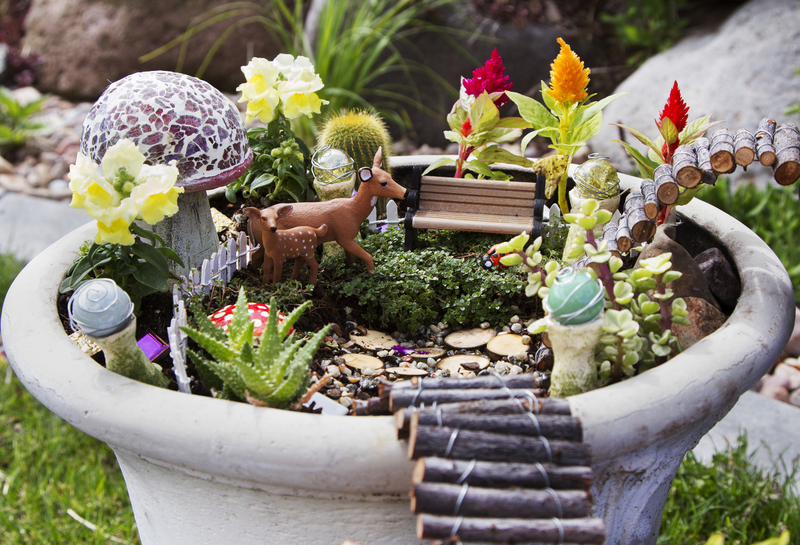Roots of Revolution: Gardening Against Climate Change
Posted on 12/06/2025
Roots of Revolution: Gardening Against Climate Change
In an age where climate change is reshaping our planet, individuals and communities are seeking actionable, local solutions to make a positive impact. Enter the green revolution: Gardening against climate change. This growing movement empowers everyone--from urban dwellers to rural homesteaders--to take meaningful steps toward reversing environmental degradation right in their back yards.

Understanding the Connection: Gardens and Global Warming
The roots of revolution lie deep within our soils. At a glance, a garden is a patch of beauty and bounty. Look closer, however, and you'll find that gardens have a profound influence on the atmosphere. Gardening to fight climate change harnesses natural processes to sequester carbon, improve soil health, and support biodiversity, helping mitigate the impact of rising global temperatures.
How Gardening Helps the Planet
- Carbon Sequestration: Plants absorb carbon dioxide as they grow, storing it in their leaves, stems, and roots.
- Soil Health: Healthy soils trap carbon and reduce greenhouse gas emissions.
- Biodiversity: Diverse gardens serve as sanctuaries for pollinators, birds, and beneficial microbes.
- Water Management: Gardens increase water infiltration and decrease runoff, supporting aquifers and reducing flooding.
- Food Security: Growing your own food reduces the carbon footprint associated with industrial agriculture and transportation.
The Science Behind Gardening for Climate Resilience
Rooting out climate change begins with understanding the carbon cycle. Every plant, from towering oak to backyard tomato, plays a part in absorbing atmospheric CO2. Organic gardening practices, such as mulching, composting, and permaculture, actively return carbon to the soil. Over time, these techniques build up the soil's organic matter, locking away carbon safely underground.
Soil as a Carbon Sink
Did you know soil can store more carbon than the atmosphere and all plant life combined? It's true! By focusing on regenerative gardening methods, anyone can transform a patch of ground into an effective carbon sink.
- No-till gardening: Disturbing the soil as little as possible maintains its structure and carbon content.
- Composting: Recycling kitchen waste enriches garden beds and supports soil life while storing carbon.
- Perennial planting: Deep-rooted perennials stabilize soil and store carbon long-term.
*Gardening against global warming* is easier than you might think. Small efforts scale up when multiplied across hundreds of thousands of gardens worldwide.
Designing a Climate-Friendly Garden: Practical Steps
Whether you're starting from scratch or looking to transform your existing landscape, here's how to begin your own gardening revolution against climate change.
1. Choose Native and Drought-Tolerant Plants
- Native species thrive in local conditions, require less water, and support local wildlife.
- Drought-tolerant plants reduce the need for irrigation, conserving water and energy.
- Pollinator-friendly choices sustain bees, butterflies, and birds, enhancing ecosystem resilience.
2. Adopt Organic and Regenerative Methods
- Avoid synthetic fertilizers and pesticides to preserve beneficial soil organisms and pollinators.
- Use organic compost to feed plants naturally, boost soil fertility, and improve water retention.
- Rotate crops and plant cover crops to maintain soil health and prevent erosion.
3. Embrace No-Dig and Mulching Practices
- No-dig gardening minimizes soil disturbance, keeping carbon stored in the ground.
- Mulching with leaves, straw, or wood chips suppresses weeds, conserves moisture, and enriches soil as it breaks down.
4. Manage Water Sustainably
- Rainwater harvesting systems supply gardens without stressing municipal water sources.
- Drip irrigation delivers water efficiently to plant roots, reducing evaporation waste.
- Swales and contour beds help redirect and retain rainwater, preventing runoff and soil erosion.
5. Encourage Biodiversity
- Plant a variety of species to create a resilient ecosystem that can withstand climate stresses.
- Build habitats like birdhouses, bee hotels, and pond edges for supporting urban wildlife.
Urban Gardening Against Global Warming
Cities are on the frontlines of climate change, yet they brim with potential for climate-resilient gardening. *Urban community gardens, rooftop green spaces, and vertical plant walls* counteract the urban heat island effect, filter air pollution, and turn concrete jungles into carbon sinks.
Community Gardens: A Force for Change
- Build social ties while growing food, herbs, and pollinator habitats.
- Expand green cover to cool neighborhoods and absorb atmospheric carbon.
- Reduce food miles and associated emissions by producing fresh, local food.
Rooftop Gardening
- Make use of otherwise wasted space for food and flower production.
- Insulate buildings, cut energy costs, and absorb stormwater runoff.
- Attract birds and beneficial insects, supporting city biodiversity.
Innovative Approaches to Sustainable Gardening
Modern gardeners employ creative strategies for climate-friendly impact. Here are some trending gardening innovations that can help you join this global movement:
- Forest Gardening: Mimic natural woodlands by growing layers of edibles and perennials for a self-sustaining, low-maintenance space.
- Permaculture Design: Integrate water management, companion planting, and soil building for efficient, holistic gardens that work in harmony with nature.
- Bioswales and Rain Gardens: Capture and filter stormwater runoff, reducing pollution and replenishing groundwater.
- Edible Landscaping: Blend food plants, flowers, and shrubs to enhance aesthetics while increasing food resilience and biodiversity.
- Seed Saving: Preserve and propagate resilient, climate-adapted varieties of fruits, vegetables, and flowers.
The Bigger Impact: Gardens as Climate Education Tools
Every garden is a classroom. By gardening to combat climate change, you demonstrate environmental stewardship for your family, neighbors, and community. Educating others about sustainable practices, the importance of biodiversity, and the value of local food production grows collective action--and hope--for the future.
Gardens for Schools and Youth Programs
- Teach climate science, composting, and food growing to the next generation.
- Foster a connection to nature, building environmental awareness from an early age.
- Empower kids with practical skills for sustainability and resilience.
Overcoming Challenges: From Barriers to Bloom
Many aspiring eco-friendly gardeners face hurdles, such as limited space, restrictive rules, or lack of resources. Innovative solutions are sprouting up everywhere:
- Container gardening allows those with balconies or patios to grow flowers, herbs, and veggies in pots and troughs.
- Shared gardens and allotments democratize green space in densely populated urban centers.
- Community tool libraries reduce costs and waste by sharing equipment among gardeners.
- Online forums and local gardening clubs spread knowledge, seeds, and support.
Global Gardens: Grassroots Movements Making a Difference
From the Victory Gardens of the past to today's climate victory gardens, history has shown the power of gardens to galvanize change.
- "Plant for the Planet" is a global youth initiative committed to reforesting the earth through community planting efforts.
- Transition Towns advocate local food resilience and urban agriculture to lessen dependence on fossil fuels.
- Permaculture networks in every continent connect resilient gardeners for shared learning and action.
Ultimately, the roots of revolution reach as far as we are willing to nurture them. *Each seed sown, each compost pile turned, every yard rewilded--together these add up to a planetary-scale response to the climate crisis.*

How You Can Start Your Gardening Revolution
Ready to dig in? Here are some steps to join the movement of gardening against climate change:
- Assess your space: Whether you have a window box or an acre, every garden counts.
- Plan for biodiversity: Mix edibles, flowers, native plants, and pollinator habitats.
- Compost and mulch: Build healthy soil and lock carbon underground.
- Grow resilient plants: Try drought-resistant, perennial, and locally adapted species.
- Share your journey: Inspire friends, neighbors, and your community to join in.
Conclusion: The Green Roots of Change
Climate change may be a daunting challenge, but gardens provide a pathway to hope and action. Gardening for climate change mitigation is a powerful form of grassroots activism, one that begin with just a handful of seeds but grows into a living legacy--a patchwork of solution-oriented landscapes, a flourishing community of change-makers, and a healthier planet for tomorrow.
By cultivating gardens that sequester carbon, support biodiversity, and reconnect people with the earth, each of us becomes part of the roots of revolution--nourishing a better world from the ground up.
Further Reading:
Start your own climate revolution through gardening today, and let your backyard be the root of global change.


